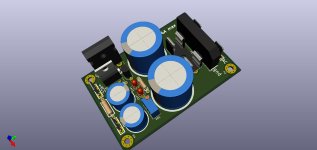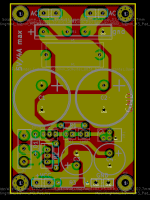I am using a LM317L with CCS at 10mA (instead of LM334) and it works fine.I found some answers. I did not saw L-adaptor guide at first look. PSRR -70dB or less 10Hz to 100kHz.
Jumper are used to set right voltage range and VR1 to trim it more. For the current do I use R2? How to set current for 330mA?
LM334Z is also very hard to find. Any replacement?
I made a PCB for a specific RPI source.
Attachments
@champ04
Hi, you are welcome. Its possible the NUC draws near its max current spec only during boot up. Difficult to ever throttle when not used for games and/or heavy video streaming. At 27V-19V in-out DC there's 8V across D11. Say this NUC draws even a mild 1A often, that's 8W. Not surprising it dissipates enough from the sink. Such things need measured statistics to really say of course. If it was 24V DC rectified it would have been less spendy. Its also possible the 100VA transformer gives more than 18 VAC at low average current draw and wall power is not 115V but 120V+
So for computer etc. 5V in-out DC is safely higher than 2.5V minimum but 8V can be unnecessarily high.
Hi, you are welcome. Its possible the NUC draws near its max current spec only during boot up. Difficult to ever throttle when not used for games and/or heavy video streaming. At 27V-19V in-out DC there's 8V across D11. Say this NUC draws even a mild 1A often, that's 8W. Not surprising it dissipates enough from the sink. Such things need measured statistics to really say of course. If it was 24V DC rectified it would have been less spendy. Its also possible the 100VA transformer gives more than 18 VAC at low average current draw and wall power is not 115V but 120V+
So for computer etc. 5V in-out DC is safely higher than 2.5V minimum but 8V can be unnecessarily high.
RE: Killawatt meter. Maybe in storage somewhere. I'll try to find one.
In the meantime, I swapped the 18V trans for a 15V/50VA . Getting 21+V rectified and have it trimmed down to 17V at the output. The computer still runs on 17V. But I get blinking LED. So I doubled up the 6800u caps. Blinking LED is less but still happens during start-up and while using the Qobuz PC app.
As an aside,..I didn't realize that Qobuz was that CPU intensive. Far more going on in the background than Foobar or MusicBee, even when playing imported files. That's lame. I guess it's working hard to decode and reassemble the files.
Anyway, Not sure which direction to go. 15V trans gives me blinkin LED. 18V trans gives me a lot of heat. With good sinking I can keep the temp reasonable with the 18V but the Vdif is still up around 7V. Not sure what sort of problems that yields long term.
Even though the 15V trans is shy of the 4.7A that the smps puts out the computer still runs. I do have a second identical 15V/50VA trans that I can run in parallel.
I noticed that @vgeorge used the l-adapter for the same NUC i3. If you are reading this "vgeorge" , what transformer did you use? Thanks!
In the meantime, I swapped the 18V trans for a 15V/50VA . Getting 21+V rectified and have it trimmed down to 17V at the output. The computer still runs on 17V. But I get blinking LED. So I doubled up the 6800u caps. Blinking LED is less but still happens during start-up and while using the Qobuz PC app.
As an aside,..I didn't realize that Qobuz was that CPU intensive. Far more going on in the background than Foobar or MusicBee, even when playing imported files. That's lame. I guess it's working hard to decode and reassemble the files.
Anyway, Not sure which direction to go. 15V trans gives me blinkin LED. 18V trans gives me a lot of heat. With good sinking I can keep the temp reasonable with the 18V but the Vdif is still up around 7V. Not sure what sort of problems that yields long term.
Even though the 15V trans is shy of the 4.7A that the smps puts out the computer still runs. I do have a second identical 15V/50VA trans that I can run in parallel.
I noticed that @vgeorge used the l-adapter for the same NUC i3. If you are reading this "vgeorge" , what transformer did you use? Thanks!
I used this one : https://sklep.toroidy.pl/en_US/p/TTSA0080-Transformer-AUDIO-TSA80VA-voltage-to-50V-/311
I think 2X10V with secondaries in series. The modushop chassis sides I use for heat sinking is adequate.
I think 2X10V with secondaries in series. The modushop chassis sides I use for heat sinking is adequate.
Try the 18VAC transfo again now with the doubled up capacitance. Measure how much AC it really gives when the system is working for music. How much in excess? Maybe put small value 5W power resistors between the secondary wires and the PCB's AC connector to absorb some of the excess. Say 0.47R for a test. Keep the L-Adapter's output setting for the NUC i3 at Intel's 19V DC nominal spec.So I doubled up the 6800u caps. Blinking LED is less but still happens during start-up and while using the Qobuz PC app.
As an aside,..I didn't realize that Qobuz was that CPU intensive. Far more going on in the background than Foobar or MusicBee, even when playing imported files. That's lame. I guess it's working hard to decode and reassemble the files.
Anyway, Not sure which direction to go. 15V trans gives me blinkin LED.
@vgeorge , Thanks for the info. I appreciate it.
@Salas , I measured my AC at 117-118V out of the wall, depending on whether geothermal system is on, etc. I'm going to try your suggestion to use some resistors but I have to wait until new ones arrive. If things don't work out, I'll be back with another update. But I'm assuming this will work just fine. Thanks again for all of the help.
@Salas , I measured my AC at 117-118V out of the wall, depending on whether geothermal system is on, etc. I'm going to try your suggestion to use some resistors but I have to wait until new ones arrive. If things don't work out, I'll be back with another update. But I'm assuming this will work just fine. Thanks again for all of the help.
Update: I tried putting some 12W resistors between secondaries and AC input. Started with 0.6R and worked my way all the way up to 15R before getting the Vdif <5V. But, as you might suspect, this caused too much current limitation (I'm assuming) because the NUC won't power on with this configuration. You can tell the current is restricted because it takes longer for the LED to come up to full brightness when first plugging in. Presumably as the caps charge.
I think I'm just going to get a different transformer.
I think I'm just going to get a different transformer.
You worked your way up in successive tests with the NUC connected and running your usual audio software?
I built and have run for a couple of years now the L-Adapter to replace an SMPS for an HP Thinclient with no problems or excessive heating.Update: I tried putting some 12W resistors between secondaries and AC input. Started with 0.6R and worked my way all the way up to 15R before getting the Vdif <5V. But, as you might suspect, this caused too much current limitation (I'm assuming) because the NUC won't power on with this configuration. You can tell the current is restricted because it takes longer for the LED to come up to full brightness when first plugging in. Presumably as the caps charge.
I think I'm just going to get a different transformer.
https://www.diyaudio.com/community/threads/l-adapter.336685/post-5944782
Granted the foraged repurposed transformer is overkill, 21.5 volt @6amp, but the L-Adapter is rock solid stable providing the 19.5 v and 3.42A the SMPS was rated for.
I upgraded the Thin client to one requiring a 19.5v/4.74A SMPS and found no difference in heating or any voltage drop booting or running.
Now using an HP t610-Plus with RME PCIe audio card.
I used no jumper on the output control and only the VR to set the output voltage.
Last edited:
I use Indel 200VA 2x17V 5.88A toroid for NUC I3 (19V DC, Roon ROCK server).
https://www.tme.eu/hu/en/details/tst200w_2x17v/toroidal-transformers/indel/tst-200-008/
In this heatsinked case working two L-Adapter (19V for NUC, 12V for Cisco core switch).
https://www.ebay.com/itm/2728507214...TKQP/K6lCNakXQ1YBMVVJQBg==|tkp:Bk9SR_6fqOr3YQ
The heatsinks are only lukewarm.
https://www.tme.eu/hu/en/details/tst200w_2x17v/toroidal-transformers/indel/tst-200-008/
In this heatsinked case working two L-Adapter (19V for NUC, 12V for Cisco core switch).
https://www.ebay.com/itm/2728507214...TKQP/K6lCNakXQ1YBMVVJQBg==|tkp:Bk9SR_6fqOr3YQ
The heatsinks are only lukewarm.
Why you not buy 80VA with one secondaries 20V. With your zou have only 40VA with two secondaries in series.I used this one : https://sklep.toroidy.pl/en_US/p/TTSA0080-Transformer-AUDIO-TSA80VA-voltage-to-50V-/311
I think 2X10V with secondaries in series. The modushop chassis sides I use for heat sinking is adequate.
The VA of the transformer is the same whether the secondaries are in series or parallel. (20V X 4A or 10V X 8A) But I ordered 2X10V transformer, in order to be able to use it to other applications. However as my NUC i3 is only used for music, there is no heat on the transformer and minimal heat on the sinks.
https://www.electronics-tutorials.ws/transformer/multiple-winding-transformers.html
https://www.electronics-tutorials.ws/transformer/multiple-winding-transformers.html
I have a question on different voltages.
I have on my audio rack the need for 3 different voltages.
5v,9v and 12v
Is there any other solution than having 3 different L-Adapters?
I have on my audio rack the need for 3 different voltages.
5v,9v and 12v
Is there any other solution than having 3 different L-Adapters?
If its 9V for a network switch and 5V for a google tv adapter there isn't much to worry about. Noise in the common ground will be better than using their original smps little adapters.Something like LM 317 you mean?does it degrade the quality of L adapter?
- Home
- Amplifiers
- Power Supplies
- L-Adapter

